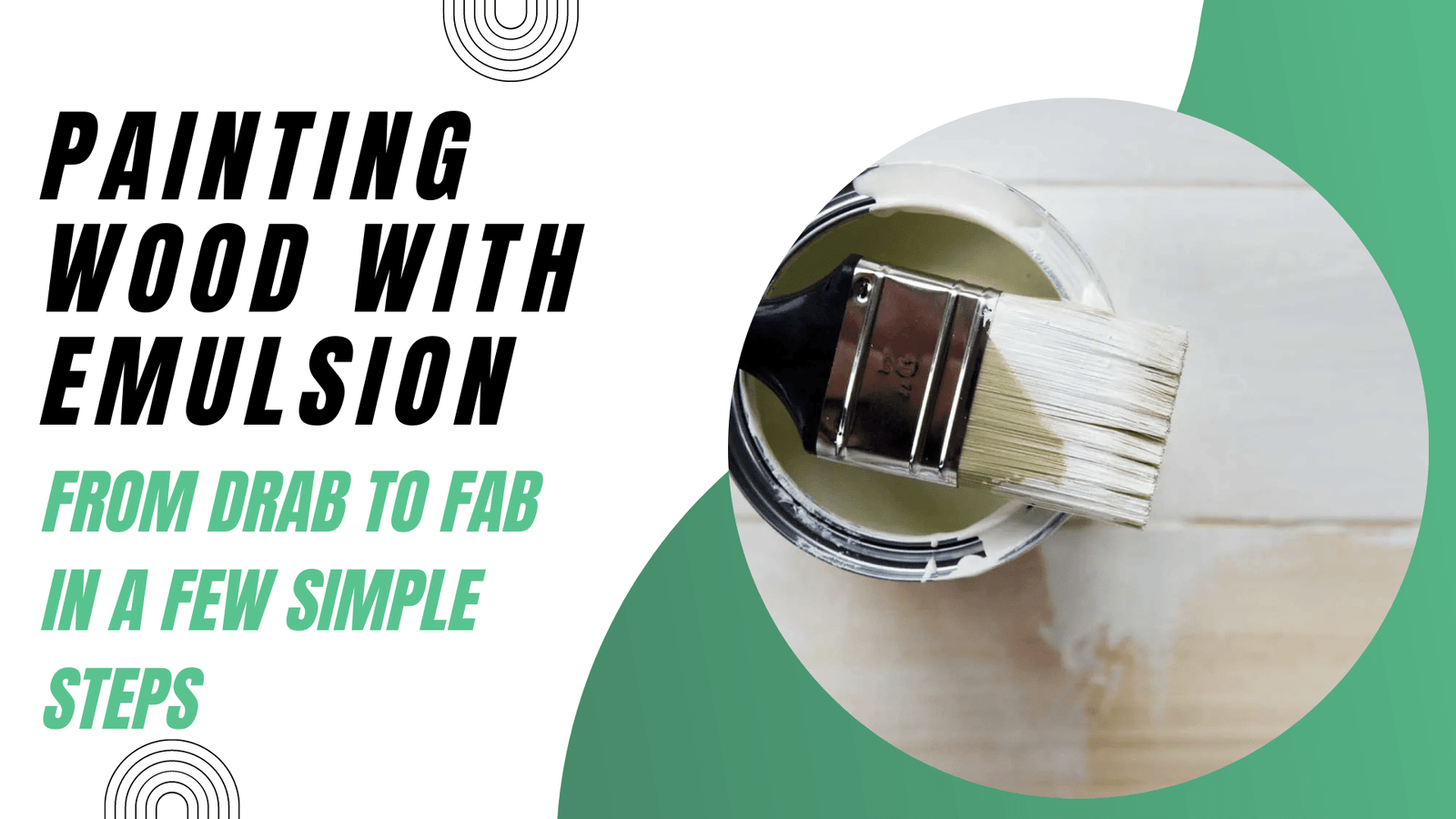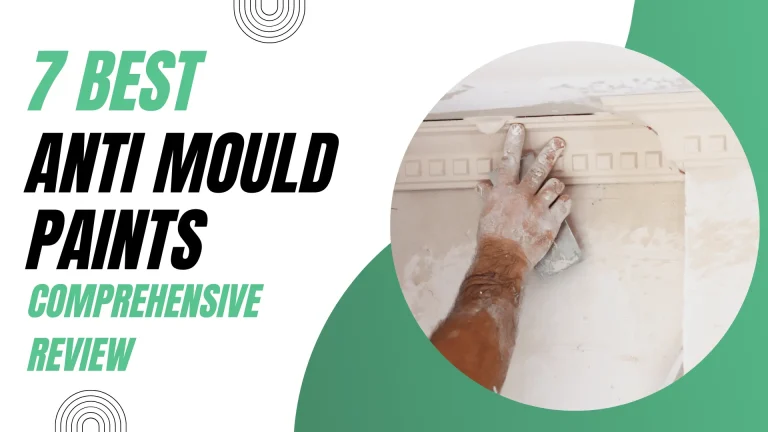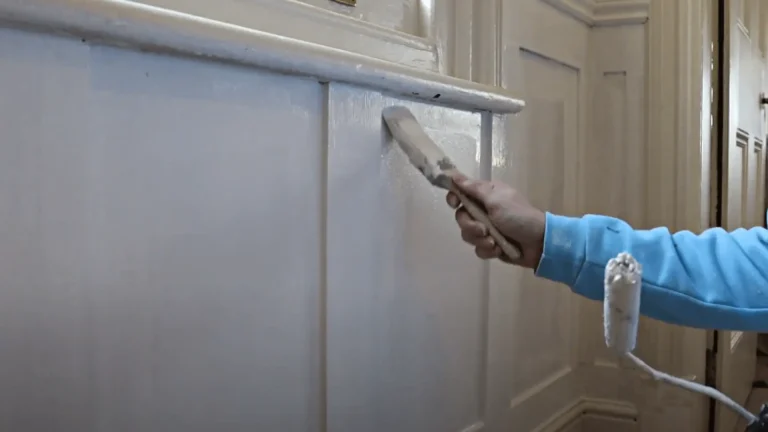Painting Wood with Emulsion: From Drab to Fab in a Few Simple Steps

DIY DOJO is reader-supported. We may earn an affiliate commission when you buy through links on our site. Find out more.
Painting wood with emulsion is a cost-effective and easy way to transform drab and tired-looking wooden furniture or surfaces into a fresh and vibrant new look. Emulsion paint is typically used on interior walls, but it can also be applied to wood with excellent results.
Whether you’re looking to update your kitchen cabinets or give your wooden bookshelves a new lease of life, painting with emulsion is a great DIY project that can be completed in a few simple steps. In this article, we’ll explore the basics of painting wood with emulsion, including preparation, application, and finishing.
So if you’re ready to give your wooden surfaces a fabulous new look, keep reading!
Can you use emulsion on wooden doors?
Emulsion paint is a water-based paint that is commonly used for interior and exterior walls, but can it be used on wooden doors? The short answer is yes, you can use emulsion paint on wooden doors, but there are a few things you need to consider before doing so. Firstly, emulsion paint is not as durable as other types of paint, such as oil-based or acrylic paints.
Secondly, it is essential to prepare the wooden door properly before applying the emulsion paint. Thirdly, it is essential to use a primer before applying the emulsion paint to ensure good adhesion and coverage. Lastly, it is vital to choose the right type of emulsion paint for your wooden door.
In short, while it is possible to use emulsion paint on wooden doors, it may not be the most durable option, and proper preparation and use of a primer are essential for a good result. If you are unsure about whether emulsion paint is the right choice for your wooden door, it may be best to consult a professional painter or decorator.
What happens if you paint wood with emulsion?
Emulsion paint is a water-based paint that is commonly used to decorate walls and ceilings in homes and buildings. It is not typically recommended for painting wood because wood is a porous material that can absorb water, causing the wood to expand and potentially warp or crack.
Additionally, emulsion paint is not designed to withstand the wear and tear that wood is subject to, so it may not provide adequate protection for the wood. While emulsion paint can be used on wood, it is important to keep in mind that it may not provide the same level of durability and protection as other types of paint specifically designed for wood.
If the wood surface will be subject to heavy use or exposure to the elements, it may be better to use a paint specifically designed for wood, such as an oil-based paint or a polyurethane varnish. Overall, while it is possible to paint wood with emulsion, it is not typically the best option for providing long-lasting protection and durability for the wood.
How to seal Painting Wood with Emulsion?
Emulsion paint is a popular choice for decorating wooden surfaces, such as doors, window frames, and furniture. However, emulsion paint can be susceptible to peeling or chipping on wood if it is not properly sealed. We will discuss the steps you can take to seal emulsion paint on wood effectively.
Step 1: Clean the surface: Before sealing the emulsion paint, it is essential to clean the surface thoroughly to ensure the sealant adheres correctly. Use a damp cloth or sponge to wipe down the surface and remove any dust or debris.
Step 2: Sand the surface: To ensure that the sealant can adhere to the emulsion paint, it is essential to sand the surface lightly. Use fine-grit sandpaper to sand the surface lightly in circular motions. This will create a rough surface that the sealant can bond to effectively.
Step 3: Apply the sealant: The next step is to apply the sealant. Choose a sealant that is suitable for use on emulsion paint and wood surfaces. There are various types of sealants available, including water-based and oil-based sealants. Allow the sealant to dry completely before proceeding to the next step.
Step 4: Sand the surface again (Optional): Once the sealant has dried, you may choose to sand the surface again lightly to create a smoother finish. Use fine-grit sandpaper to sand the surface lightly in circular motions. Be careful not to sand too hard and remove the sealant. Once you have finished sanding, use a clean cloth or vacuum cleaner to remove any dust created by the sanding.
Step 5: Apply a second coat (Optional): If you feel that the first coat of sealant is not enough, you can apply a second coat. Follow the same process as before, applying the sealant evenly using a brush or roller. Allow the second coat to dry completely before using the surface.
By following the steps outlined above, you can ensure that the emulsion paint on your wooden surfaces is protected from damage and lasts longer.
Emulsion paint on wood paneling

Emulsion paint is a popular type of water-based paint that is commonly used on walls and ceilings. However, it can also be used on wood paneling to create a smooth and uniform finish. Here are some things you should know about using emulsion paint on wood paneling:
- Preparation: Before applying emulsion paint to wood paneling, it is important to prepare the surface properly. This involves sanding the wood to create a smooth surface and removing any dirt or debris that may be present. You should also prime the wood to ensure that the emulsion paint adheres properly and provides an even finish.
- Choosing the right paint: When choosing emulsion paint for wood paneling, it is important to select a high-quality product that is designed specifically for this purpose. Look for a paint that is formulated to provide good coverage and a durable finish. It is also important to choose the right color and finish to complement your décor.
- Applying the paint: Emulsion paint can be applied to wood paneling using a paintbrush, roller, or sprayer. When applying the paint, it is important to work in small sections and ensure that the paint is applied evenly. You may need to apply more than one coat of paint to achieve the desired finish.
- Drying time: Emulsion paint typically dries quickly, but it is important to allow sufficient time for the paint to dry completely before applying a second coat or touching the surface. The drying time may vary depending on the brand of paint and the conditions in the room.
- Maintenance: Once the emulsion paint has dried, it is important to maintain the finish by cleaning the surface regularly and avoiding any harsh chemicals or abrasive materials that may damage the paint.
Just make sure to prepare the surface properly, choose high-quality paint, apply it evenly, and allow sufficient drying time for the best results.
Can you use Dulux matt paint on wood?
The answer is yes, you can use Dulux matte paint on wood. However, it is important to note that not all types of matte paint are suitable for use on wood. Dulux has a range of matte paints that are specifically designed for use on wood surfaces. Before applying Dulux matte paint to wood, you need to ensure that the wood surface is properly prepared.
This includes cleaning the surface to remove any dirt or debris and sanding it to create a smooth and even surface for the paint to adhere to. You may also need to apply a primer or undercoat to the wood surface to ensure that the paint adheres properly.
Once the wood surface is properly prepared, you can apply Dulux matte paint using a brush or roller. It is important to apply the paint evenly and to allow it to dry thoroughly between coats. You may need to apply multiple coats of paint to achieve the desired level of coverage.
Conclusion:
In conclusion, painting wood with emulsion can be a simple and effective way to transform the appearance of your furniture, skirting boards, walls, or other wooden surfaces. Emulsion paint is easy to apply and can be used to achieve a range of different effects, from a smooth, glossy finish to a more textured, matte look.
By following a few basic steps, such as preparing the wood surface properly and using the right type of emulsion paint, you can achieve professional-looking results without the need for expensive equipment or specialist skills. So whether you’re looking to update your home décor or restore old wooden items, painting with emulsion is definitely worth considering as a quick and easy DIY project.







yandanxvurulmus.kV0YGupgmVl2